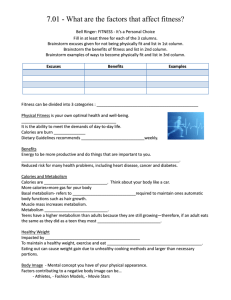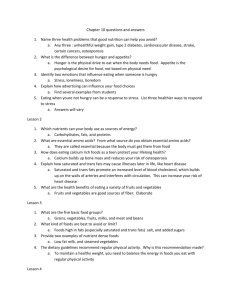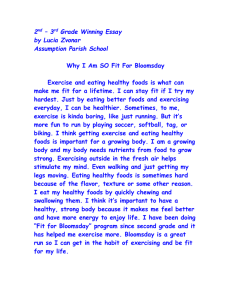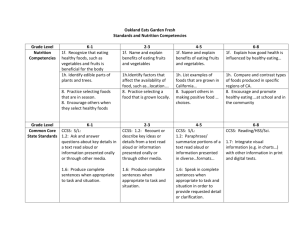7.01 - What are the factors that affect fitness? Bell Ringer: FITNESS
advertisement
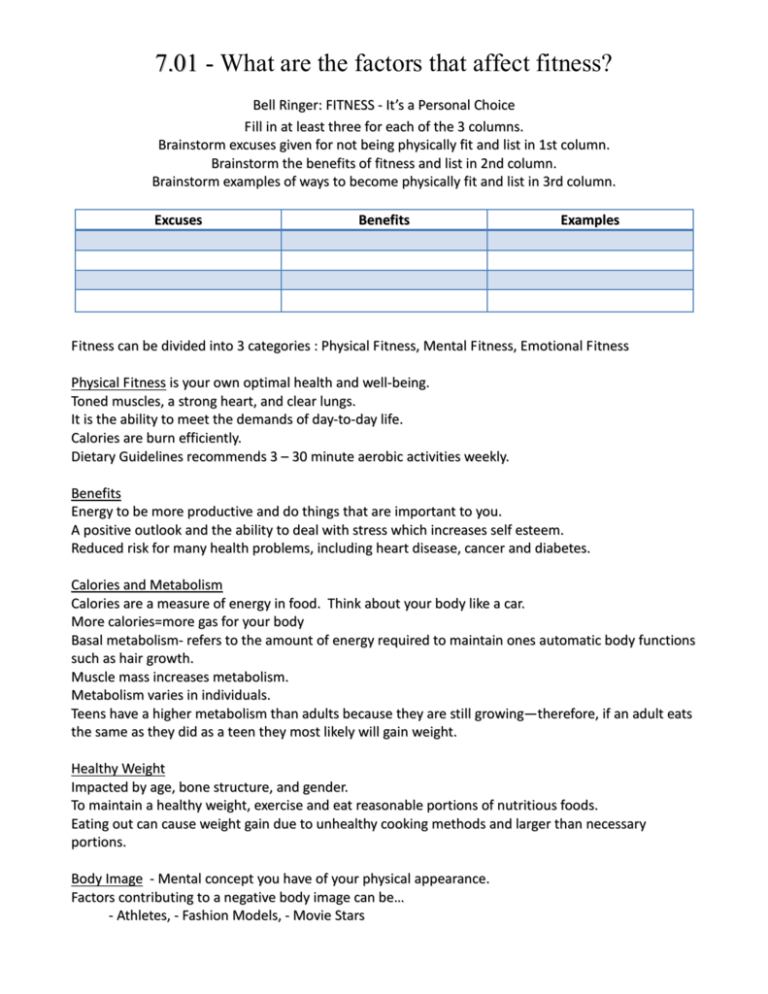
7.01 - What are the factors that affect fitness? Bell Ringer: FITNESS - It ’s a Personal Choice F ill in at least three for each of the 3 columns. Brainstorm excuses given for not being physically fit and list in 1st column. Brainstorm the benefits of fitness and list in 2nd column. Brainstorm examples of ways to become physically fit and list in 3rd column. Excuses Benefits Examples F itness can be divided into 3 categories : Physical F itness, Mental F itness, Emotional F itness Physical F itness is your own optimal health and well-being. Toned muscles, a strong heart, and clear lungs. It is the ability to meet the demands of day-to-day life. Calories are burn efficiently. Dietary Guidelines recommends 3 – 30 minute aerobic activities weekly. Benefits Energy to be more productive and do things that are important to you. A positive outlook and the ability to deal with stress which increases self esteem. Reduced risk for many health problems, including heart disease, cancer and diabetes. Calories and Metabolism Calories are a measure of energy in food. Think about your body like a car. More calories=more gas for your body Basal metabolism- refers to the amount of energy required to maintain ones automatic body functions such as hair growth. Muscle mass increases metabolism. Metabolism varies in individuals. Teens have a higher metabolism than adults because they are still growing—therefore, if an adult eats the same as they did as a teen they most likely will gain weight. Healthy Weight Impacted by age, bone structure, and gender. To maintain a healthy weight, exercise and eat reasonable portions of nutritious foods. Eating out can cause weight gain due to unhealthy cooking methods and larger than necessary portions. Body Image - Mental concept you have of your physical appearance. Factors contributing to a negative body image can be… - Athletes, - Fashion Models, - Movie Stars Boasting Body Image Make sure the people around you make you feel good about yourself, no matter your size. Make sensible decisions about what you eat. If you need help, ask a dietitian. Focus on the inside, and let your body take its natural shape. Body Mass Index (BMI) Uses weight in relation to height and age to help determine whether you are in an appropriate weight range. Helps to determine if you are underweight(-15%) or possibly overweight(+15%). Being Overweight Weighing 15% more than what your physician recommends. Inactivity is a considering factor. Heart disease, high blood pressure, and certain cancers are associated with being overweight. Losing Weight Develop healthful eating and exercise habits. Lose weight safely by eating larger portions of healthy foods. Include foods from all food groups Being Underweight Weight should be gained slowly and steadily by choosing low-fat, nutrient and calorie dense foods. Individuals who weigh at least 15% less than the healthy weight recommended by their physician are considered underweight. Lowered resistance to infections, reduced muscle strength, and malnutrition are related to being underweight. Eating Disorders Abnormal eating patterns that threaten a person’s health. Anorexia nervosa- involves an extreme urge to lose weight by self-starvation. Can be life-threatening. Bulimia- overeating and then purging (vomiting). Fad Diets Usually are unsuccessful because they promise quick and easy weight loss. Avoid plans that make you purchase special foods. Examples: Developing an Effective F itness Plan Always start a plan by seeing your physician first. Good nutrition Exercise Focus on changing eating habits for a lifetime. Know your body - for example if you have a larger bone structure, you will weigh more. Classwork Assignment – Below draw an outline of a human who you consider to have a healthy shape. On the arms and legs, write 3 different ways to be physically healthy. Around the head, write 3 ways to be mentally healthy. And in the chest/heart area, write 3 ways to be emotionally healthy. Score____/ 9 THEN Define these words according to Skills for Living starting on page 286: 1. Calorie- 2. Basal Metabolism- 3. Body Mass Index (BMI)- 4. Overweight- 5. Underweight- 6. Obese- Score:_____/ 6 Total:____/ 15 7.02 Teen Living How does assessing personal eating habits affect personal wellness? Bell Ringer - You have 3 minutes to list all the snacks you can think of that begin with the letters above. List at least 2 for each letter. Nutrients – products that come from foods that help the body grow and function. There are 6 Nutrients: -Carbohydrates -Vitamins -Proteins -Minerals -Fats -Water Carbohydrates Carbohydrates are the body’s main source of energy. There are two kinds of carbohydrates: Simple Carbohydrates = Sugars Complex Carbohydrates = Starches, Fiber Simple Carbohydrates are found in fruit, vegetables and milk. Complex Carbohydrates are found in breads, cereal, pasta, rice, dry beans, potatoes and corn. Protein Proteins are nutrients used to build, maintain, and repair body tissues. Made up of amino acids – chemical compounds Your body makes all but 9 of the amino acids. Those 9 are called essential amino acids. Complete proteins = have 9 essential amino acids (animal sources) Incomplete proteins = lack 1 or more of the essential amino acids (plant sources) Fats The most concentrated form of food energy Two types: Saturated fats – solid at room temperature Unsaturated fats – liquid at room temperatures Vitamins Your body requires at least 13 vitamins each day. Two Categories: Fat-Soluble Vitamins – body can store these, too much of these vitamins can be harmful, examples: A, D, E, and K Water-Soluble Vitamins – not stored in the body, large doses can be harmful Minerals and Water Body requires at least 16 minerals daily Iron, Phosphorus, Sodium, Iodine, Calcium Carries nutrients to your cells Carries waste from your body Regulate your body temperature 55% - 75% of your body weight CLASSWORK – Define these words using the index of your book! 1. Nutrient- 2. Nutrition- 3. Carbohydrate- 4. Protein- 5. Amino Acid- 6. Mineral- 7. Vitamin- 8. Fat- 9. Saturated Fat- 10. Unsaturated Fat- 11. Cholesterol- Total____/11 7.02 FOOD GUIDE PYRAMID GRAINS- bread, pasta, cereal MILK, YOGURT AND CHEESE Make ½ your grains whole!!! Choose low-fat or fat-free 1 oz. (1 serving) is: 1C. Milk or yogurt 1 slice of bread 1 oz. of cheese = 4 stacked dice 1 C. of breakfast cereal ½ C. cooked rice, cereal, pasta MEAT, POULTRY, DRY BEANS, FISH, EGGS, NUTS Choose low-fat or lean meats and poultry VEGETABLE Eat more dark green and orange vegetables Vary your vegetables!!! ½ C. chopped raw or cooked vegetables (about the size of your fist) 1 c. cooked beans 3 oz. of meat/poultry (about the size of a deck of cards) 2 eggs 1 C. leafy raw vegetables 4 T. peanut butter FRUIT Focus on Fresh Fruits FATS, OILS, SWEETS, OTHER Go easy on fruit juice!!! Make most of your fat sources from fish, nuts and vegetable oils. 1 piece of medium fruit (size of a baseball) Keep saturated fats, trans fat and sodium low. ¾ C. fruit juice Choose foods and beverages low in added sugars. ½ C. canned fruit IN Class Assignment: You will each be given a flyer from a local grocery store. You are going to work with a partner and plan a meal. You have a budget of $10. Using that money, you will need to create a meal (either a breakfast, lunch or dinner) which includes all components of the food pyramid and is fairly healthy. Use the flyers to create your meal and write down your choices below. After completion, you may be asked to share your meal with the class. 7.03 Special Dietary Needs Medical Diets 1) Diabetes -a condition which the body cannot control blood sugar levels -eating the right balance of food and counting the grams of carbohydrates help control sugar levels 2) Heart Disease -lower total fat and saturated fat intake -increase soluble fiber 3) Cancer -increase fiber and lose weight 4)Allergies -abnormal, physical response to certain foods by the body’s immune system Special Nutritional Needs Athletes -An athlete’s daily food choices can make a difference between a good performance and a bad one. -Athletes have specific energy, liquid and timing needs. Supplements -nutrients that people take in addition to the foods they eat in the form of pills, powder, etc. -Should not be consumed in place of food. -Steroids are dangerous drugs that can boost performance. -Too many vitamins can be dangerous. Pregnant Women -mother is responsible for all of the baby’s nutritional needs Recommendations: -choose a variety of low-fat, nutrient dense food -boost calories slightly – You are eating for two! -eat 2 servings of high-protein foods daily -drink a lot of water -increase intake of folic acid It is healthy to gain between 25-35 pounds! Children-breast milk is the best for Infants -iron should be added to the baby formula -add solid foods gradually – 4-6 months -encourage young children to eat plenty of fruits and vegetables -children need to drink milk Classwork Assignment – Define these terms according to Skills for Living, starting on page 306 and page 314 1. Food Allergies- 2. Food Intolerance- 3. Anorexia Nervosa- 4. Bulimia NervosaTotal___/4
